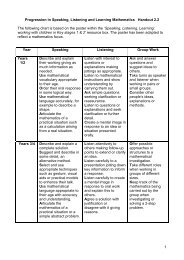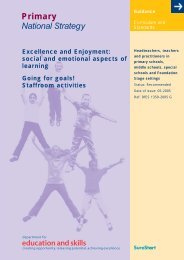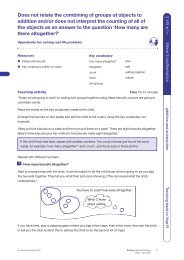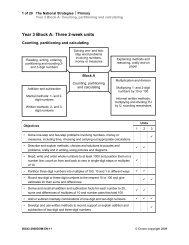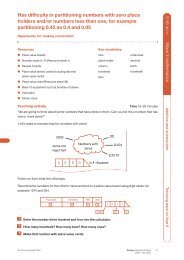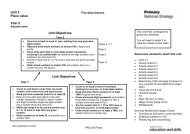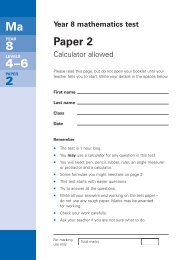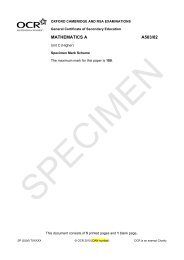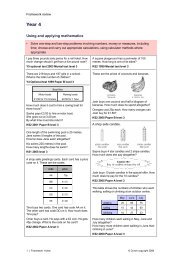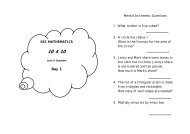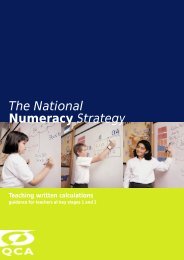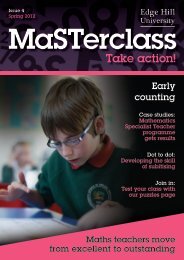Finding rules and describing patterns - Dudley Virtual Resource ...
Finding rules and describing patterns - Dudley Virtual Resource ...
Finding rules and describing patterns - Dudley Virtual Resource ...
Create successful ePaper yourself
Turn your PDF publications into a flip-book with our unique Google optimized e-Paper software.
Problem solving with<br />
EYFS, Key Stage 1 <strong>and</strong><br />
Key Stage 2 children<br />
<strong>Finding</strong> <strong>rules</strong> <strong>and</strong> <strong>describing</strong> <strong>patterns</strong>
Problem solving with<br />
EYFS, Key Stage 1 <strong>and</strong><br />
Key Stage 2 children<br />
<strong>Finding</strong> <strong>rules</strong> <strong>and</strong> <strong>describing</strong> <strong>patterns</strong><br />
First published in 2010<br />
Ref: 00528-2010PDF-EN-01
Disclaimer<br />
The Department for Education wishes to make it<br />
clear that the Department <strong>and</strong> its agents accept<br />
no responsibility for the actual content of any<br />
materials suggested as information sources in<br />
this publication, whether these are in the form of<br />
printed publications or on a website.<br />
In these materials, icons, logos, software products<br />
<strong>and</strong> websites are used for contextual <strong>and</strong> practical<br />
reasons. Their use should not be interpreted<br />
as an endorsement of particular companies or<br />
their products.<br />
The websites referred to in these materials existed<br />
at the time of going to print.<br />
Please check all website references carefully to<br />
see if they have changed <strong>and</strong> substitute other<br />
references where appropriate.
Contents<br />
The National Strategies | Primary<br />
Problem solving with EYFS, Key Stage 1 <strong>and</strong> Key Stage 2 children<br />
<strong>Finding</strong> <strong>rules</strong> <strong>and</strong> <strong>describing</strong> <strong>patterns</strong><br />
1<br />
Introduction 3<br />
Foundation Stage/Year 1 4<br />
Year 1/ Year 2<br />
Activity 1: Teddy’s presents 9<br />
Year 2/ Year 3<br />
Activity 1: Hopscotch grid 14<br />
Year 3/ Year 4<br />
Activity 1: Party bags 18<br />
Activity 2: L-shaped models 22<br />
Year 5/ Year 6<br />
Activity 1: The c<strong>and</strong>le problem 25<br />
Activity 2 : Sequence of models 30<br />
© Crown copyright 2010 00528-2010PDF-EN-01
Introduction<br />
The National Strategies | Primary<br />
Problem solving with EYFS, Key Stage 1 <strong>and</strong> Key Stage 2 children<br />
<strong>Finding</strong> <strong>rules</strong> <strong>and</strong> <strong>describing</strong> <strong>patterns</strong><br />
3<br />
This resource focuses on problems that fall into the category ‘Patterns <strong>and</strong> relationships’. To help children<br />
become good problem solvers it is important that they are taught <strong>and</strong> acquire essential skills <strong>and</strong><br />
strategies <strong>and</strong> underst<strong>and</strong> how <strong>and</strong> when to use them.<br />
When solving ‘Patterns <strong>and</strong> relationships’ problems, the strategies children need to be able to draw on<br />
include:<br />
• oral rehearsal of the pattern they can see to refine their thoughts<br />
• having a system for recording the pattern, e.g. using pictures, tables or lists of calculations<br />
• organising the recording of <strong>patterns</strong>, e.g. making an ordered list or table <strong>and</strong> adapting it as more<br />
information is collected in order to predict what comes next<br />
• eventually, <strong>describing</strong> same general term using mathematical notation even if they see the<br />
sequence differently.<br />
There are lessons for each age group across two years, <strong>and</strong> a selection of activities for the Early Years<br />
Foundation Stage, based on one theme.<br />
You should adapt the problems for the needs of your children. For example, in the Year 3/4 problem that<br />
involves party bags you could: change the number of presents in the bag; alter the rule that presents<br />
can’t be the same; change the context.<br />
Throughout the lessons, there are notes to indicate particular features that you might want to consider or<br />
look out for when working with children, indicated by the following symbol:<br />
© Crown copyright 2010 00528-2010PDF-EN-01
4 The National Strategies | Primary<br />
Problem solving with EYFS, Key Stage 1 <strong>and</strong> Key Stage 2 children<br />
<strong>Finding</strong> <strong>rules</strong> <strong>and</strong> <strong>describing</strong> <strong>patterns</strong><br />
Foundation Stage/Year 1<br />
Repeating <strong>patterns</strong><br />
Primary Framework objectives<br />
Reception<br />
• Talk about, recognise <strong>and</strong> recreate simple <strong>patterns</strong><br />
• Describe solutions to practical problems, drawing on experience, talking about their own ideas,<br />
methods <strong>and</strong> choices<br />
Year 1<br />
• Describe simple <strong>patterns</strong> <strong>and</strong> relationships involving numbers or shapes; decide whether examples<br />
satisfy given conditions<br />
• Describe ways of solving puzzles <strong>and</strong> problems, explaining choices <strong>and</strong> decisions orally or using<br />
pictures<br />
Vocabulary<br />
pattern repeat same different predict<br />
Necessary prior knowledge<br />
Some previous experience of pattern <strong>and</strong> shape would be helpful<br />
Ordinal language<br />
<strong>Resource</strong>s<br />
• Wallpaper borders with repeating<br />
<strong>patterns</strong><br />
• Gummed shapes, stamps or<br />
photocopied shapes<br />
• Drum or tambourine<br />
• Whiteboards<br />
• Interlocking plastic cubes, bricks, or<br />
construction equipment<br />
Repeating <strong>patterns</strong><br />
00528-2010PDF-EN-01 © Crown copyright 2010
The National Strategies | Primary<br />
Problem solving with EYFS, Key Stage 1 <strong>and</strong> Key Stage 2 children<br />
<strong>Finding</strong> <strong>rules</strong> <strong>and</strong> <strong>describing</strong> <strong>patterns</strong><br />
5<br />
Activity 1<br />
It will be helpful if the children have resources (stamps, photocopied images, stickers) which they can use<br />
later in the activity.<br />
Show the children some pictures or images displayed on an interactive whiteboard, including wallpaper<br />
<strong>and</strong> pictures from nature. Ask children if they know what a pattern is.<br />
Q. What other kinds of <strong>patterns</strong> are there? Can you see any <strong>patterns</strong> in the classroom, on the walls or on<br />
the floors, around the school? Are there any <strong>patterns</strong> at home, in the wallpaper, or on your clothes?<br />
It is important to build on children’s awareness of pattern in their surroundings.<br />
Encourage them to use shape <strong>and</strong> positional vocabulary to describe them.<br />
Show the children a pattern of objects along a wallpaper border (moon, star, moon, star, etc.)<br />
Allow children enough time to think <strong>and</strong> talk about their own ideas before<br />
discussing with the whole class.<br />
If you have an interactive whiteboard, you could use clip art of moons <strong>and</strong> stars to copy <strong>and</strong> paste to<br />
continue the pattern.<br />
Q. Describe what you can see to each other.<br />
Q. How many different objects are there? Is there a pattern? What is the pattern? Which object would<br />
come next in the pattern?<br />
Discuss which object is first, second, third, etc. Display some of the mathematical vocabulary as the<br />
children describe the pattern, e.g. next to.<br />
Q. Which object will be after the last one shown? How can we check that we are right?<br />
Introduce a second pattern with three objects, e.g. moon, star, sun, moon, star, sun, <strong>and</strong> so on.<br />
Using shapes on an interactive whiteboard or large cut out shapes, ask the children to demonstrate<br />
which objects would be next in the pattern.<br />
Q. How many objects are in this pattern? Which is first? Second? Third?<br />
Q. What happens next?<br />
Display some of the mathematical vocabulary as the children describe the pattern, e.g. in between.<br />
Q. What will the next object be? And the next? Why?<br />
Show the children a pattern using two objects where one is repeated, e.g. star, star, moon, star, star,<br />
moon, etc.<br />
Q. How many objects are in this pattern? What is first? Second? Third?<br />
And then what happens?<br />
© Crown copyright 2010 00528-2010PDF-EN-01
6 The National Strategies | Primary<br />
Problem solving with EYFS, Key Stage 1 <strong>and</strong> Key Stage 2 children<br />
<strong>Finding</strong> <strong>rules</strong> <strong>and</strong> <strong>describing</strong> <strong>patterns</strong><br />
Q. What object will be next? And the next?<br />
Clarify children’s underst<strong>and</strong>ing of the terms ‘same’ <strong>and</strong> ‘different/difference’.<br />
Encourage the use of them when children are in discussion pairs. Ensure that<br />
they see that there are many different possibilities.<br />
Give the children the resources (e.g. stamps, stickers, photocopied shapes) to make their own <strong>patterns</strong><br />
using the same objects. Ask them to make different <strong>patterns</strong> to yours. They should discuss what is the<br />
same <strong>and</strong> what is different about their <strong>patterns</strong>.<br />
Drawing together<br />
Ask children to close their eyes while you cut a border into three pieces.<br />
Encourage children to use mathematical vocabulary about shape <strong>and</strong> position.<br />
Q. How can we reorder these to create a pattern? What clues can we use?<br />
Ask children to hide part of their pattern while their partners close their eyes.<br />
Q. What’s hidden? How do you know?<br />
You could also use a ‘slidy box’ format or hide-<strong>and</strong>-reveal facility on an interactive whiteboard.<br />
Activity 2<br />
Think about referring to pattern on an interactive display to support some children when they are<br />
discussing pattern generally.<br />
Ask the children to sit in a circle.<br />
Explain that you are going to show the children a pattern, <strong>and</strong> that they will need to describe what the<br />
pattern is. Ask the first child in the circle to stay sitting, the second child to st<strong>and</strong> up, the third child to<br />
stay sitting, the fourth child to st<strong>and</strong> up, <strong>and</strong> so on.<br />
Stop at a given point <strong>and</strong> ask:<br />
Q. What am I going to ask the next child to do? Explain how you know.<br />
Initial assessment opportunities are important here through focused <strong>and</strong><br />
targeted questioning.<br />
Choose a child within the circle <strong>and</strong> discuss whether they will be sitting or st<strong>and</strong>ing when their turn comes.<br />
The children could also be clapping, clicking fingers, doing arm movements, crossing <strong>and</strong> uncrossing<br />
legs or arms, spinning around, etc.<br />
Q. How do you know?<br />
Start the pattern again at a different point in the circle. Introduce the word ‘predict’ <strong>and</strong> encourage the<br />
children to predict whether the fifth child in the circle will be sitting or st<strong>and</strong>ing. What about the tenth?<br />
Q. How did you work it out? What information did you use?<br />
00528-2010PDF-EN-01 © Crown copyright 2010
The National Strategies | Primary<br />
Problem solving with EYFS, Key Stage 1 <strong>and</strong> Key Stage 2 children<br />
<strong>Finding</strong> <strong>rules</strong> <strong>and</strong> <strong>describing</strong> <strong>patterns</strong><br />
7<br />
Encourage children to use mathematical vocabulary about shape <strong>and</strong> position.<br />
Move the group to a larger space where there is freedom to move. Ask the children to work in groups of<br />
four to create a pattern using themselves so that the pattern is two different shapes <strong>and</strong> then repeated<br />
by the other two children.<br />
Invite the groups of children to the front <strong>and</strong> ask the others to describe the <strong>patterns</strong>.<br />
Q. Can you go to the fifth position <strong>and</strong> make yourself into the shape that makes the repeating<br />
pattern correct?<br />
Encourage the children to all st<strong>and</strong> very tall, up on tiptoe, arms, h<strong>and</strong>s <strong>and</strong> fingers reaching to the sky.<br />
Explain that this is the first shape in a pattern. Now ask the children to stretch their arms out <strong>and</strong> their<br />
fingers wide <strong>and</strong> to crouch down low. Explain that this is the next shape in the pattern.<br />
Ask them to make the first shape, then the second, <strong>and</strong> so on. Use a drum or a tambourine to tap when<br />
you want the children to change to the next position . This will develop listening skills <strong>and</strong> provide a<br />
sense of order to the pattern.<br />
Q. Can anyone think of another shape to add to our pattern?<br />
Encourage one child to demonstrate a shape <strong>and</strong> another to describe the shape they have made.<br />
Emphasise the mathematical vocabulary used.<br />
Now ask all children to form the first shape on the first bang of the drum <strong>and</strong> hold it for a few seconds.<br />
On the second bang children move into position for the next shape, <strong>and</strong> then finally on the third bang<br />
children move into the last shape.<br />
Q. How many different shapes have we created?<br />
Q. Is this a repeated pattern?<br />
Q. How could the pattern become a repeated pattern?<br />
Opportunities for explanation <strong>and</strong> reasoning here will assess children’s underst<strong>and</strong>ing<br />
of ‘repeated <strong>patterns</strong>’. Allow children time to reflect before they respond.<br />
Take responses from the children.<br />
Q. Can anyone describe to us how our three movements could become a repeated pattern?<br />
Ask pairs to discuss how they could change the three movements into a repeated pattern of movements.<br />
Choose one pair to demonstrate.<br />
Q. How many movements did the pair make in total? What was the first shape they made? The second?<br />
The third? Then what happened?<br />
Q. How many times did they repeat the first sequence of movements?<br />
Ask children to make up their own sequence of two or three movements <strong>and</strong> to repeat it, forming a<br />
pattern. Ask several pairs to perform their <strong>patterns</strong>.<br />
Q. How many different shapes were in their pattern? Which was first? Second? Third?<br />
What did they do next?<br />
© Crown copyright 2010 00528-2010PDF-EN-01
8 The National Strategies | Primary<br />
Problem solving with EYFS, Key Stage 1 <strong>and</strong> Key Stage 2 children<br />
<strong>Finding</strong> <strong>rules</strong> <strong>and</strong> <strong>describing</strong> <strong>patterns</strong><br />
Activity 3<br />
Give each pair or group of children construction equipment or interlocking cubes/bricks of different colours<br />
<strong>and</strong> sizes. Ask the children to look at the individual cubes/bricks <strong>and</strong> describe them to each other.<br />
Encourage more-able children to use size as well as colour or to have three rather than two different bricks<br />
in their <strong>patterns</strong>.<br />
There is an opportunity for assessment of objective as children engage in a more<br />
independent activity.<br />
Q. Can you create a line of blocks which shows a repeating pattern?<br />
Q. Can you describe your pattern to somebody else at your table?<br />
If the children find this too easy, ask one child to remove two blocks from different places in the pattern.<br />
Display two coloured cubes in the centre of an interactive whiteboard or on a flip chart. Tell the children<br />
that this is the middle of a repeating pattern.<br />
Q. Can anyone from the group suggest how we might add some cubes to the right or left h<strong>and</strong> side<br />
to continue the pattern?<br />
Q. How did you use the information to start the pattern?<br />
Q. Did you have to change your ideas as the pattern was added to?<br />
Activity 4<br />
Use an example of a number sequence forwards <strong>and</strong> backwards that the children have been practising,<br />
e.g. counting in twos from 0 or 1, counting in fives or tens. Using a puppet, ask the children to close their<br />
eyes <strong>and</strong> listen to the puppet saying a number sequence where it misses out one or two numbers.<br />
Ask children to use their whiteboards to record the missing numbers in order.<br />
It is helpful for children to link their work on <strong>patterns</strong> with counting in particular step<br />
sizes, so that they see this is one particular kind of pattern.<br />
Q. Does this pattern continue forwards <strong>and</strong> backwards?<br />
Ask the children to listen again. This time include a deliberate mistake in the sequence (repeating<br />
numbers, reversed numbers, missing numbers), e.g. 10, 20, 30, 50, 40, 60, 70.<br />
Q. What is wrong with this pattern of numbers?<br />
Ask the children to work in pairs to write their own sequences of numbers with one deliberate mistake.<br />
They should ask another pair to spot the mistake.<br />
00528-2010PDF-EN-01 © Crown copyright 2010
Year 1/Year 2<br />
The National Strategies | Primary<br />
Problem solving with EYFS, Key Stage 1 <strong>and</strong> Key Stage 2 children<br />
<strong>Finding</strong> <strong>rules</strong> <strong>and</strong> <strong>describing</strong> <strong>patterns</strong><br />
9<br />
Activity 1: Teddy’s presents<br />
Objectives<br />
• Describe simple <strong>patterns</strong> <strong>and</strong> relationships involving numbers or shapes; decide whether examples<br />
satisfy given condition<br />
• Describe ways of solving puzzles <strong>and</strong> problems, explaining choices <strong>and</strong> decisions orally or using<br />
pictures<br />
By the end of the lesson, children will be able to:<br />
• recognise <strong>and</strong> describe a simple number sequence;<br />
• solve <strong>and</strong> explain their solution to a given problem.<br />
Vocabulary<br />
pattern sequence continue predict<br />
Necessary prior knowledge<br />
Counting, knowledge of the number<br />
system<br />
Simple addition<br />
More than, less than<br />
Recognise, say, copy <strong>and</strong> extend<br />
simple <strong>patterns</strong><br />
Teddy‛s presents<br />
Teddy is seven years old today.<br />
<strong>Resource</strong>s<br />
• Teddy bear <strong>and</strong> birthday presents<br />
(or use clip art on an interactive<br />
whiteboard)<br />
• Small cubes or multi-link<br />
Teddy has seven presents today.<br />
Each year he is given the same number of presents<br />
as his age. How many presents has he had since he<br />
was born?<br />
© Crown copyright 2010 00528-2010PDF-EN-01
10 The National Strategies | Primary<br />
Problem solving with EYFS, Key Stage 1 <strong>and</strong> Key Stage 2 children<br />
<strong>Finding</strong> <strong>rules</strong> <strong>and</strong> <strong>describing</strong> <strong>patterns</strong><br />
Main teaching activity<br />
Set the scene for the problem by saying that today is Teddy’s birthday.<br />
Show Teddy with his seven presents.<br />
Q. How many presents has Teddy got today??<br />
Q. How do you know?<br />
Q. How many presents would he have got last year if he got the same number as his age??<br />
Q. How many will he have next year?<br />
Q. How many would he have had two years ago?<br />
Q. How do you know?<br />
If children are unsure, add <strong>and</strong> remove presents to show the number for each question.<br />
Ensure that children have used language such as one more, one less, same number as how old he is, etc,<br />
<strong>and</strong> write up the vocabulary as it is used. Ask similar questions, ensuring that all children are clear.<br />
Encourage specific vocabulary so that children learn to explain clearly.<br />
Q. How many presents did Teddy have when he was one?<br />
Q. How many presents did he have altogether by the time he was two?<br />
Show this by making a pile of one present <strong>and</strong> another of two presents. Make sure the children<br />
underst<strong>and</strong> that Teddy has this year’s present but also last year’s present <strong>and</strong> that they need to be<br />
added together.<br />
If you are using clip art on an interactive whiteboard, copy <strong>and</strong> paste the first present <strong>and</strong> then add one<br />
more present.<br />
Discuss how you might record this in a way that is clear to everyone. Suggestions might include using<br />
cubes or multi-link, pictures, tallies, or calculations (1, 1 + 2, ...), or a mixture of these. Demonstrate some<br />
of these ways of recording for the c<strong>and</strong>les blown out by the time Teddy is two.<br />
Select a few children, whom you have overheard clearly explaining what they are<br />
doing, for feedback..<br />
Ask children to work in pairs, choose a method of recording <strong>and</strong> use this to show the number of presents<br />
for Teddy’s first, second, third <strong>and</strong> fourth birthdays.<br />
Drawing together<br />
Choose a variety of recordings, but no more than three, e.g. a picture recording, a cube recording <strong>and</strong> a<br />
calculation recording, <strong>and</strong> invite children to explain what they have done.<br />
Q. Which way of recording is clear <strong>and</strong> helps us to work out what we need to know quickly?<br />
Q. Which helps us to see how the pattern of the presents grows?<br />
Q. Could we find out how many presents Teddy will have next year, from these recordings?<br />
Ensure that children are aware of:<br />
• the cumulative nature of the number of presents;<br />
• the need to record in clear columns to see the pattern growing.<br />
00528-2010PDF-EN-01 © Crown copyright 2010
The National Strategies | Primary<br />
Problem solving with EYFS, Key Stage 1 <strong>and</strong> Key Stage 2 children<br />
<strong>Finding</strong> <strong>rules</strong> <strong>and</strong> <strong>describing</strong> <strong>patterns</strong><br />
11<br />
Show children how to move from using cubes to using pencil <strong>and</strong> paper, keeping recording in columns,<br />
e.g.<br />
l 1<br />
l ll 3<br />
l ll lll 6<br />
Differentiation may be necessary for those children who are not secure with counting, or totalling to 28,<br />
<strong>and</strong> for those who find the answer quickly. You may ask some children to find the number of presents<br />
received when Teddy is five, or eight.<br />
Now ask the children:<br />
Q. If Teddy is seven years old today, what is the total number of presents he has been given since he<br />
was born?<br />
Explain that they won’t be able to answer the question straight away.<br />
Ask children to check that their partner underst<strong>and</strong>s what the question is asking <strong>and</strong> to discuss what<br />
they will do to solve it. Say that they may change the way they record if they can now see a better way of<br />
doing it, or they may stay with their own recording.<br />
This paired discussion gives an opportunity for children to develop their reasoning<br />
skills <strong>and</strong> use of vocabulary.<br />
Allow children time to work on the problem in pairs.<br />
Circulate <strong>and</strong> observe surprises – children who exceed expectations or don’t<br />
meet expectations. Be aware of a dominant partner, <strong>and</strong> target questions at the<br />
passive partner to ensure underst<strong>and</strong>ing.<br />
As you work with one or more groups, ask children to clearly show their recording for the fourth or fifth<br />
birthday <strong>and</strong> to talk about it using specific language. These may be given on cards, if the child is able to<br />
read them, e.g. more, less, altogether, as well as.<br />
If the language used is not concise, ask them to use the specific language <strong>and</strong> to practise their<br />
explanation with someone else.<br />
Practising their explanations with a partner can build confidence <strong>and</strong> provide you<br />
with some exemplar pairs to draw upon in the plenary.<br />
When they can do this, have some prepared questions ready, for example:<br />
Q. What if Teddy was eight? Could you solve this without writing or drawing?<br />
Q. What language would you use to explain it? What would be the important words?<br />
Q. What questions can you ask a partner?<br />
When most children have solved the problem ask them to share their thinking with another pair at their<br />
table so that all four underst<strong>and</strong> each other’s work.<br />
© Crown copyright 2010 00528-2010PDF-EN-01
12 The National Strategies | Primary<br />
Problem solving with EYFS, Key Stage 1 <strong>and</strong> Key Stage 2 children<br />
<strong>Finding</strong> <strong>rules</strong> <strong>and</strong> <strong>describing</strong> <strong>patterns</strong><br />
Plenary<br />
Collect answers to the seventh birthday presents question with the class. If there are different answers,<br />
explore why <strong>and</strong> deal with misconceptions.<br />
Help children to recognise that there is more than one way of recording, but that<br />
some ways are clearer or more useful than others.<br />
Q. Was your recording easy to underst<strong>and</strong>?<br />
Q. Did anyone change their way of recording because they found a better way?<br />
Q. Can you explain what was clearer about it?<br />
Look for examples of other clear recordings that show the accumulated facts <strong>and</strong> a clear column<br />
structure.<br />
Discuss <strong>patterns</strong> that children have noticed. Draw out:<br />
• increasing <strong>patterns</strong> from recording, i.e. that we include all the years before <strong>and</strong> then this year’s birthday;<br />
• number <strong>patterns</strong>, e.g. in recording<br />
1 + 2<br />
1 + 2 + 3<br />
Other <strong>patterns</strong> which children may have noticed are:<br />
• In the solution 1, 3, 6, 10, 15, 21, 28<br />
the differences are 2, 3, 4, 5, 6, 7<br />
i.e. the last number that was added is Teddy’s new age.<br />
• Triangle shapes are made by the way in which the presents are arranged, represented by cubes.<br />
l<br />
l ll<br />
l ll lll<br />
l ll lll llll<br />
l ll lll llll lllll<br />
l ll lll llll lllll llllll<br />
l ll lll llll lllll llllll lllllll<br />
Review how the following recording is easier for some children to add up, <strong>and</strong> make reference to bonds<br />
to 10 if some children noticed this.<br />
1<br />
1 2<br />
1 2 3<br />
1 2 3 4<br />
1 2 3 4 5<br />
1 2 3 4 5 6<br />
1 2 3 4 5 6 7<br />
00528-2010PDF-EN-01 © Crown copyright 2010
The National Strategies | Primary<br />
Problem solving with EYFS, Key Stage 1 <strong>and</strong> Key Stage 2 children<br />
<strong>Finding</strong> <strong>rules</strong> <strong>and</strong> <strong>describing</strong> <strong>patterns</strong><br />
13<br />
Now that children underst<strong>and</strong> the problem, they should be able to make an<br />
informed guess, or be able to say how we can work it out.<br />
Q. If Teddy was eight, can you predict how many presents he would have received?<br />
For those who have done this, ask how many presents Teddy would have received if he was ten.<br />
Q. How could we test this?<br />
Invite one child to do this.<br />
Q. What were the most useful strategies we used to help us answer the problem?<br />
Q. Can we make a list to help us remember for next time?<br />
− talking about the question to underst<strong>and</strong> what it is asking us<br />
− clear recording<br />
− talking <strong>and</strong> explaining<br />
− looking for <strong>patterns</strong>.<br />
It is important that children see that these strategies could be used to solve other<br />
problems, not just this one.<br />
© Crown copyright 2010 00528-2010PDF-EN-01
14 The National Strategies | Primary<br />
Problem solving with EYFS, Key Stage 1 <strong>and</strong> Key Stage 2 children<br />
<strong>Finding</strong> <strong>rules</strong> <strong>and</strong> <strong>describing</strong> <strong>patterns</strong><br />
Year 2/Year 3<br />
Activity 1: Hopscotch grid<br />
Objectives<br />
• Identify <strong>patterns</strong> <strong>and</strong> relationships involving numbers or shapes, <strong>and</strong> use these to solve problems.<br />
• Describe <strong>and</strong> explain methods, choices <strong>and</strong> solutions to puzzles <strong>and</strong> problems, orally <strong>and</strong> in writing,<br />
using pictures <strong>and</strong> diagrams.<br />
• Read, write <strong>and</strong> order whole numbers to at least 1000...; count on from <strong>and</strong> back to zero in singledigit<br />
steps or multiples of ten.<br />
By the end of the lesson, children will be able to:<br />
• describe the rule of a pattern or relationship in own words or pictures;<br />
• test predicted terms to see if a possible rule works;<br />
• use pattern to work out the tenth term in a sequence.<br />
Vocabulary<br />
pattern number sequence increase first, second, tenth, etc.<br />
Necessary prior<br />
knowledge<br />
Counting in threes <strong>and</strong> fives<br />
Odd <strong>and</strong> even numbers<br />
Hopscotch grid<br />
<strong>Resource</strong>s<br />
• Hopscotch grid<br />
• Digit cards<br />
00528-2010PDF-EN-01 © Crown copyright 2010
The National Strategies | Primary<br />
Problem solving with EYFS, Key Stage 1 <strong>and</strong> Key Stage 2 children<br />
<strong>Finding</strong> <strong>rules</strong> <strong>and</strong> <strong>describing</strong> <strong>patterns</strong><br />
15<br />
Main teaching activity<br />
Draw a hopscotch grid on the board or display one on an interactive board.<br />
It may be helpful if children have jotters or rough books available.<br />
Now ask the children questions such as the following:<br />
• Start behind 1. Hop, jump, hop. What number are you on?<br />
• Start behind 1. After a sequence of five moves are you on an odd or an even number?<br />
• What happens if you make two more moves in the sequence?<br />
• If we continue the grid pattern beyond 10, will 15 be in a single square or in a pair of squares?<br />
• What is the difference between each of the numbers in the single squares? What is the difference between<br />
each number in the right-h<strong>and</strong> square of the pair of squares?<br />
• What if the starting number was 3? Would the pattern change? What would the number be in the square<br />
currently holding 10? And in the square holding 99?<br />
After the initial input ask the children:<br />
Q. What number <strong>patterns</strong> can you see?<br />
Allow children time to discuss in pairs before taking feedback. Jot down all the number <strong>patterns</strong> they<br />
have spotted. Be prepared for them seeing <strong>patterns</strong> that you have not spotted yourself!<br />
This paired discussion will involve more children <strong>and</strong> allow them time to practise<br />
explaining their ideas before contributing to the whole-class discussion.<br />
Encourage children to describe the <strong>patterns</strong> <strong>and</strong> the <strong>rules</strong> that they noticed. The sorts of questions you<br />
could ask could include:<br />
Q. What is happening to the numbers in the:<br />
− single squares<br />
− left-h<strong>and</strong> double squares<br />
− right-h<strong>and</strong> double squares?<br />
© Crown copyright 2010 00528-2010PDF-EN-01
16 The National Strategies | Primary<br />
Problem solving with EYFS, Key Stage 1 <strong>and</strong> Key Stage 2 children<br />
<strong>Finding</strong> <strong>rules</strong> <strong>and</strong> <strong>describing</strong> <strong>patterns</strong><br />
Q. Can you say what the rule is?<br />
Q. Can you continue the sequence in the:<br />
−<br />
−<br />
−<br />
single squares?<br />
In the left-h<strong>and</strong> double square?<br />
In the right-h<strong>and</strong> double square?<br />
Q. Will the tenth number in the single-square sequence be odd or even?<br />
Q. Can you predict what the tenth number will be in the right-h<strong>and</strong> double-square sequence?<br />
Q. Why is it easier to predict this tenth number than the tenth number in the other two sequences?<br />
The suggested questions are not a definitive list. You will need to pursue<br />
questions that build on the <strong>patterns</strong> <strong>and</strong> relationships that your children spot.<br />
Encourage children to sketch the grid to test their hypotheses.<br />
Assess children’s underst<strong>and</strong>ing by asking questions such as ‘How do you know?’<br />
<strong>and</strong> ‘Why do you think that?’ Give them time to explain a range of <strong>patterns</strong>.<br />
Some children may find it helpful to list the single square numbers in order to help them see the pattern<br />
of odd <strong>and</strong> even numbers.<br />
There is enough material in a grid like this to span more than one lesson.<br />
Ask children to continue working in pairs to discuss, explain <strong>and</strong> record the <strong>patterns</strong> they find.<br />
Drawing together<br />
Encourage the children to discuss the strategies that they have used to predict numbers, e.g. ‘I knew<br />
the sequence was the 3 times table, so I knew the tenth number would be 3 × 10’, ‘I noticed that the<br />
numbers in the second <strong>and</strong> fourth single squares were even numbers so I knew that the number in the<br />
tenth square would be an even number’.<br />
Q. Would number 14 be in a single square? Would 17 be in a double square? Explain to your partner<br />
how you know.<br />
It is important that children have opportunities to rehearse explaining their reasoning<br />
orally before they are expected to record their reasoning in writing.<br />
Some children will be able to do this by working with odds <strong>and</strong> evens <strong>and</strong> number <strong>patterns</strong>; others will<br />
need to sketch the extension to the grid. Where children have used sketches, encourage them to show<br />
them to the rest of the class.<br />
Q. What if the grid started at 3?<br />
Explore this idea of ‘What if …?’ statements with the children <strong>and</strong> give them time to create some of their<br />
own. They can explore grids with different starting numbers.<br />
Here you are giving support to children so that they can ask their own<br />
‘What if. . . ?’ questions.<br />
00528-2010PDF-EN-01 © Crown copyright 2010
The National Strategies | Primary<br />
Problem solving with EYFS, Key Stage 1 <strong>and</strong> Key Stage 2 children<br />
<strong>Finding</strong> <strong>rules</strong> <strong>and</strong> <strong>describing</strong> <strong>patterns</strong><br />
17<br />
Plenary<br />
Q. Can you design a hopscotch grid made up of single <strong>and</strong> double squares so that 6, 11 <strong>and</strong> 16 are in<br />
single squares? Convince your partner.<br />
Using questions like these creates good opportunities for you to assess children’s<br />
underst<strong>and</strong>ing of the number <strong>patterns</strong> they have been working with.<br />
If, after some discussion, children have not spotted that these numbers increase by 5 each time, you<br />
could ask them to describe the pattern of numbers, <strong>and</strong> ask what numbers will need to go in between.<br />
Give children time to rehearse explaining their thoughts to their mathematics partners <strong>and</strong> then choose<br />
some to explain their thoughts to the class.<br />
This rehearsal should help children to clarify thoughts <strong>and</strong> so improve the quality of<br />
their explanations to the class.<br />
© Crown copyright 2010 00528-2010PDF-EN-01
18 The National Strategies | Primary<br />
Problem solving with EYFS, Key Stage 1 <strong>and</strong> Key Stage 2 children<br />
<strong>Finding</strong> <strong>rules</strong> <strong>and</strong> <strong>describing</strong> <strong>patterns</strong><br />
Year 3/Year 4<br />
Activity 1: Party bags<br />
Objectives<br />
• Identify <strong>and</strong> use <strong>patterns</strong>, relationships <strong>and</strong> properties of numbers or shapes; investigate a statement<br />
involving numbers <strong>and</strong> test it with examples<br />
• Describe <strong>and</strong> explain methods, choices <strong>and</strong> solutions to puzzles <strong>and</strong> problems, orally <strong>and</strong> in writing,<br />
using pictures <strong>and</strong> diagrams<br />
By the end of the lesson, children will be able to:<br />
• recognise, describe <strong>and</strong> continue a number sequence;<br />
• explain their generalisations.<br />
Vocabulary<br />
• pattern sequence continue predict rule<br />
Necessary prior<br />
knowledge<br />
• Counting, knowledge of the<br />
number system<br />
• Knowing strategies for adding<br />
several numbers<br />
• Familiarity with more than,<br />
less than<br />
• Recognise, say, copy <strong>and</strong> extend<br />
simple <strong>patterns</strong><br />
Party bags<br />
Jack is having a birthday party <strong>and</strong> giving out<br />
party bags to his friends.<br />
<strong>Resource</strong>s<br />
• Presents <strong>and</strong> bags<br />
• Clip art of similar<br />
How many different party bags with two presents<br />
in each can be made with 10 different items?<br />
00528-2010PDF-EN-01 © Crown copyright 2010
The National Strategies | Primary<br />
Problem solving with EYFS, Key Stage 1 <strong>and</strong> Key Stage 2 children<br />
<strong>Finding</strong> <strong>rules</strong> <strong>and</strong> <strong>describing</strong> <strong>patterns</strong><br />
19<br />
Introduce the problem by saying Jack is having a party. Explain that he is giving out party bags to his<br />
friends. Each friend will get two presents <strong>and</strong> each bag will be different.<br />
Q. If Jack has four presents to choose from, how many different party bags can he make?<br />
Q. Can you explain your method to your partner?<br />
Explaining to a partner allows children to clarify their thinking.<br />
Q. What is the best way to record to keep track of the different party bags?<br />
Circulate <strong>and</strong> listen to the children’s responses as they begin to consider how they might solve the<br />
problem.<br />
Take feedback from the children, recording their method on the board. If it’s not suggested, say one<br />
possible way to record is using symbols. For example, we can give each of the presents a letter:<br />
A B C D<br />
AB BC CD DE<br />
AC BD CE<br />
AD BE<br />
AE<br />
Ask the children to work with a partner <strong>and</strong> record how many different party bags there would be if<br />
there were five presents <strong>and</strong> six presents.<br />
Inviting pairs to discuss together provides a good speaking <strong>and</strong> listening opportunity. It also helps to<br />
develop their reasoning skills.<br />
Q. Did you change your method of recording? Why?<br />
Q. How many party bags are there <strong>and</strong> can you explain your thinking?<br />
Q. How could you display the information for the number of party bags with four, five <strong>and</strong> six presents?<br />
Circulate <strong>and</strong> listen to children’s predictions <strong>and</strong> reasoning.<br />
© Crown copyright 2010 00528-2010PDF-EN-01
20 The National Strategies | Primary<br />
Problem solving with EYFS, Key Stage 1 <strong>and</strong> Key Stage 2 children<br />
<strong>Finding</strong> <strong>rules</strong> <strong>and</strong> <strong>describing</strong> <strong>patterns</strong><br />
Take feedback <strong>and</strong> record suggestions including recording the information in a table.<br />
Number of presents Number of party bags Total<br />
4 AB BC CD<br />
AC BD<br />
AD<br />
5 AB BC CD DE<br />
AC BD CE<br />
AD BE<br />
AE<br />
6 AB BC CD DE EF<br />
AC BD CE DF<br />
AD BE CF<br />
AE BF<br />
AF<br />
6<br />
10<br />
15<br />
Q. How would we add the information for three party bags to the table?<br />
Q. Can you predict how many party bags there would be for seven presents?<br />
Ask the children to add the information to the table.<br />
Number of presents Number of party bags Total<br />
3 AB BC<br />
AC<br />
4 AB BC CD<br />
AC BD<br />
AD<br />
5 AB BC CD DE<br />
AC BD CE<br />
AD BE<br />
AE<br />
6 AB BC CD DE EF<br />
AC BD CE DF<br />
AD BE CF<br />
AE BF<br />
AF<br />
7 AB BC CD DE EF FG<br />
AC BD CE DF EG<br />
AD BE CF DG<br />
AE BF CG<br />
AF BG<br />
AG<br />
3<br />
6<br />
10<br />
15<br />
21<br />
Q. What <strong>patterns</strong> do you notice? Ask the children to feedback on all the <strong>patterns</strong> they can see.<br />
00528-2010PDF-EN-01 © Crown copyright 2010
The National Strategies | Primary<br />
Problem solving with EYFS, Key Stage 1 <strong>and</strong> Key Stage 2 children<br />
<strong>Finding</strong> <strong>rules</strong> <strong>and</strong> <strong>describing</strong> <strong>patterns</strong><br />
21<br />
Drawing together<br />
Q. Can we use the information in the table to work out how many party bags there would be if we had<br />
11 different presents?<br />
Agree we can add on to the total – the number added increases by one each time so:<br />
21 + 7 + 8 + 9 + 10<br />
Or we can see from the number of party bags displayed each time we can add:<br />
1 + 2 + 3 + 4 + 5 + 6 + 7 + 8 + 9 + 10<br />
Q. Is there a quick way to add these numbers?<br />
Give the children a few moments to discuss this.<br />
Agree that looking for pairs that make 10 is an efficient method.<br />
This provides a useful opportunity to remind children to identify <strong>and</strong> use efficient methods of calculation.<br />
Model recording to show that four pairs make 10, <strong>and</strong> then we add 5, <strong>and</strong> then add 10, making a total of<br />
55. Make sure the children underst<strong>and</strong> that this means Jack has made 55 party bags <strong>and</strong> therefore the<br />
problem has been solved.<br />
Q. What if we were working out how many party bags Jack made with 16 presents? What numbers<br />
would we need to add?<br />
Q. Would we still look for pairs that make 10? What would pairs of numbers need to total?<br />
Establish that we could look for pairs that make 15.<br />
Plenary<br />
Q. What did we do to work out how many party bags we had?<br />
Q. Would this method always work?<br />
Q. Using what we have learned today, can you create a rule?<br />
Here, the children are learning to produce a generalised statement.<br />
Tell children that their rule should begin with this phrase: ‘To find the total number of party bags you …’<br />
<strong>and</strong> include some or all of these words: total, add, altogether, age, previous.<br />
Ask children to work in pairs to agree a rule.<br />
Invite several children to share their <strong>rules</strong> <strong>and</strong> the rest of the class to evaluate the clarity of the<br />
<strong>rules</strong> shared.<br />
© Crown copyright 2010 00528-2010PDF-EN-01
22 The National Strategies | Primary<br />
Problem solving with EYFS, Key Stage 1 <strong>and</strong> Key Stage 2 children<br />
<strong>Finding</strong> <strong>rules</strong> <strong>and</strong> <strong>describing</strong> <strong>patterns</strong><br />
Year 3/Year 4<br />
Activity 2: L-shaped models<br />
Objectives<br />
• Identify <strong>and</strong> use <strong>patterns</strong>, relationships <strong>and</strong> properties of numbers or shapes; investigate a statement<br />
involving numbers <strong>and</strong> test it with examples<br />
• Report solutions to puzzles <strong>and</strong> problems, giving explanations <strong>and</strong> reasoning orally <strong>and</strong> in writing,<br />
using diagrams <strong>and</strong> symbols<br />
• Recognise <strong>and</strong> continue number sequences formed by counting on or back in steps of constant size<br />
By the end of the lesson, children will be able to:<br />
• describe the rule of a pattern;<br />
• predict the tenth term in a pattern.<br />
Vocabulary<br />
pattern repeating pattern same different<br />
increase bigger first, second, etc.<br />
Necessary prior<br />
knowledge<br />
Some experience of recognising<br />
<strong>and</strong> <strong>describing</strong> <strong>patterns</strong><br />
L-shaped models<br />
<strong>Resource</strong>s<br />
• Interlocking plastic cubes<br />
• Squared paper<br />
00528-2010PDF-EN-01 © Crown copyright 2010
The National Strategies | Primary<br />
Problem solving with EYFS, Key Stage 1 <strong>and</strong> Key Stage 2 children<br />
<strong>Finding</strong> <strong>rules</strong> <strong>and</strong> <strong>describing</strong> <strong>patterns</strong><br />
23<br />
Main teaching activity<br />
Arrange the children so they can work in pairs, with individual whiteboards or jotters.<br />
How is paired work supporting the children?<br />
Circulate around the class <strong>and</strong> observe how the children approach the task.<br />
Discuss with the class the variety of <strong>patterns</strong> <strong>and</strong> the different ways of representing them, drawing from<br />
their previous experiences. Now display some L shapes made from interlocking plastic cubes or use<br />
shapes on an interactive whiteboard:<br />
Q. What might the next L shape in the sequence look like?<br />
Ask children to discuss this in pairs, come to an agreement <strong>and</strong> make the next L shape.<br />
Q. How many cubes might be in the next L shape?<br />
Q. How are the L shapes growing each time?<br />
Ask the children to work with their partner <strong>and</strong> use the squared paper to record what is happening to<br />
the L shape each time. Remind them of the different ways they recorded the clapping <strong>patterns</strong>, using<br />
symbols, shapes <strong>and</strong> numbers.<br />
Rehearsing descriptions/explanations in pairs involves more children <strong>and</strong> gives<br />
them the opportunity to improve their vocabulary. It also can help them feel more<br />
confident in front of the class.<br />
Make sure that there are enough cubes available for the children <strong>and</strong> some squared paper for recording.<br />
Q. How can you record the way the L shape grows, using numbers?<br />
Q. Would it be useful to create a table?<br />
Q. Would it be helpful to draw the L shape each time?<br />
While children are engaged in this activity look for examples that show different ways<br />
of working to use in the plenary.<br />
Ask children to continue finding the number of cubes in the sequence of L shapes. Encourage them to<br />
predict the number before making each shape.<br />
Q. Can you predict the number of cubes in the tenth L shape? What about the fifteenth shape?<br />
The twenty-first shape?<br />
Q. How can you work out what the 50th shape looks like without drawing out the L shapes?<br />
© Crown copyright 2010 00528-2010PDF-EN-01
24 The National Strategies | Primary<br />
Problem solving with EYFS, Key Stage 1 <strong>and</strong> Key Stage 2 children<br />
<strong>Finding</strong> <strong>rules</strong> <strong>and</strong> <strong>describing</strong> <strong>patterns</strong><br />
Plenary<br />
Use children’s work to look at the number pattern that has been created.<br />
Q. What <strong>patterns</strong> can you see in the numbers you have written down?<br />
Q. Can you explain to your partner what the rule is?<br />
The children should have spotted that the pattern is the sequence of odd numbers.<br />
Look at the sequence of odd numbers on a number line; ensure that children can articulate that the<br />
sequence starts at 1 <strong>and</strong> increases by two each time.<br />
Q. Do you need to make or draw the L shape to predict the next number in the sequence?<br />
Q. Can you <strong>and</strong> your partner make a shape that would grow in the sequence of even numbers?<br />
Allow children time to discuss <strong>and</strong> investigate.<br />
You could challenge the children to investigate other letter shapes such as T <strong>and</strong> E in this lesson or in<br />
subsequent lessons. Children could use cubes or squared paper <strong>and</strong> record their results in tables.<br />
Q. Can you <strong>and</strong> your partner explain to each other why you must start with an even number of cubes?<br />
Q. Can you use what you have learned today to predict or work out how many cubes there would be<br />
in the tenth shape?<br />
Agree that if the pattern is the sequence of odd numbers, then the tenth shape will have the tenth odd<br />
number of cubes.<br />
Draw the following table on the board:<br />
Shape 1 2 3 4 5 6 7 8 9 10<br />
Number<br />
of cubes<br />
2 4 6 8 10 12 ?<br />
Q. This pattern is the sequence of even numbers. Is there a quicker way of finding the number of cubes<br />
in the tenth shape than counting in twos?<br />
Encourage children to see the relationship between the number of the shape <strong>and</strong> the number of cubes<br />
in it.<br />
Q. Can they predict what the twentieth shape would be? Would it be easier to draw the shape or to use<br />
the table? Why?<br />
00528-2010PDF-EN-01 © Crown copyright 2010
Year 5/Year 6<br />
The National Strategies | Primary<br />
Problem solving with EYFS, Key Stage 1 <strong>and</strong> Key Stage 2 children<br />
<strong>Finding</strong> <strong>rules</strong> <strong>and</strong> <strong>describing</strong> <strong>patterns</strong><br />
25<br />
Activity 1: The c<strong>and</strong>le problem<br />
Objective<br />
• Represent <strong>and</strong> interpret sequences, <strong>patterns</strong> <strong>and</strong> relationships involving numbers <strong>and</strong> shapes;<br />
suggest <strong>and</strong> test hypotheses; construct <strong>and</strong> use simple expressions <strong>and</strong> formulae in words then<br />
symbols (e.g. the cost of c pens at 15 pence each is 15c pence)<br />
• Explain reasoning <strong>and</strong> conclusions, using words, symbols or diagrams as appropriate<br />
By the end of the lesson, children will be able to:<br />
• express the general term in words <strong>and</strong> begin to do this algebraically.<br />
Vocabulary<br />
pattern sequence term predict generalise<br />
Necessary prior knowledge<br />
Recognise <strong>and</strong> extend number<br />
sequences<br />
Some experience of relating a term<br />
to its position in the sequence<br />
Know the relationship between<br />
the areas of right-angled isosceles<br />
triangles <strong>and</strong> squares<br />
The c<strong>and</strong>le problem<br />
Mrs Gillespie is 73 today. She has had a birthday cake<br />
<strong>and</strong> c<strong>and</strong>les every year siunce she was born.<br />
<strong>Resource</strong>s<br />
• A3 paper for paper mat activity<br />
• Squared paper available, if<br />
required<br />
How many c<strong>and</strong>les has she blown out in her lifetime?<br />
© Crown copyright 2010 00528-2010PDF-EN-01
26 The National Strategies | Primary<br />
Problem solving with EYFS, Key Stage 1 <strong>and</strong> Key Stage 2 children<br />
<strong>Finding</strong> <strong>rules</strong> <strong>and</strong> <strong>describing</strong> <strong>patterns</strong><br />
Main teaching activity<br />
Set the context of the problem. Mrs Gillespie is 73 today. She has had a birthday cake every year since she<br />
was born. How many c<strong>and</strong>les has she blown out in her lifetime?<br />
Ask children to work with a partner <strong>and</strong> discuss what their underst<strong>and</strong>ing of the problem is <strong>and</strong> what<br />
kind of recording may be useful. Remind children that recording needs to be systematic <strong>and</strong> easy to<br />
refer to.<br />
Circulate <strong>and</strong> listen for discussion demonstrating efficient ways of recording.<br />
Drawing together<br />
Establish that everyone underst<strong>and</strong>s the problem <strong>and</strong> that everyone is clear about the method of<br />
recording they will use.<br />
If there are several children who do not know how to record, ask a child whom you have overheard to<br />
explain their method.<br />
Work with the uncertain children to begin with until they are secure in recording.<br />
Allow children to explore <strong>and</strong> enjoy the problem for a short while. It is likely that the children will see that<br />
they could add 1 + 2 + 3… 72 + 73, which will take a long time to calculate.<br />
When children begin to realise that this will take a very long time, draw them<br />
together again.<br />
Drawing together<br />
Q. What problems have you come up against?<br />
Discuss problems children have experienced. Pick up on the fact that finding a solution could take a very<br />
long time.<br />
Q. What can we do so that we don’t have to write down all the numbers of c<strong>and</strong>les <strong>and</strong> add them up?<br />
Ask children to take a few minutes to discuss possibilities <strong>and</strong> establish that we need to develop a rule<br />
that will get us to the answer more quickly.<br />
Say that you are going to go back to an arrangement of the c<strong>and</strong>les to see what <strong>patterns</strong> <strong>and</strong><br />
information can be gained from it. Say that simplifying a problem by using smaller numbers can often<br />
help us to underst<strong>and</strong> how we can solve it, perhaps seeing <strong>patterns</strong> that we don’t see when using larger<br />
numbers.<br />
Suggest that the c<strong>and</strong>les could be drawn like this:<br />
I<br />
I I<br />
I I I<br />
I I I I<br />
This represents the c<strong>and</strong>les blown out in four years.<br />
00528-2010PDF-EN-01 © Crown copyright 2010
The National Strategies | Primary<br />
Problem solving with EYFS, Key Stage 1 <strong>and</strong> Key Stage 2 children<br />
<strong>Finding</strong> <strong>rules</strong> <strong>and</strong> <strong>describing</strong> <strong>patterns</strong><br />
27<br />
Circulate <strong>and</strong> select a group which is moving towards using square numbers.<br />
Prepare them to show their thinking to the class before drawing together.<br />
Q. Can you see <strong>patterns</strong> in:<br />
• the way the diagram grows?<br />
• the shape it makes on the paper?<br />
• the numbers generated?<br />
• the number of rows <strong>and</strong> columns?<br />
Say that these may be things children want to consider.<br />
You could use a ‘place mat’ activity to generate discussion <strong>and</strong> creativity in looking for useful <strong>patterns</strong>/<br />
relationships.<br />
Put the first four rows in the centre of the mat. Divide the mat into four.<br />
Each child has a few minutes to jot down anything they notice in their space. They then share with a<br />
partner <strong>and</strong> refine their ideas, discarding anything that will not be useful. Each pair then shares with the<br />
other pair until they come up with a group consensus.<br />
Drawing together<br />
Ask the chosen children to describe what they see. Draw out:<br />
• the number of rows <strong>and</strong> the number of columns are the same;<br />
• this number is Mrs Gillespie’s age, i.e. the number of c<strong>and</strong>les on the most recent cake, the number of<br />
c<strong>and</strong>les added to the previous total;<br />
• the shape formed by the c<strong>and</strong>les is a right-angled isosceles triangle (it looks like half of a square).<br />
Say that when Mrs Gillespie was five she would have blown out the following number of c<strong>and</strong>les in her<br />
lifetime:<br />
I . . . .<br />
I I . . .<br />
I I I . .<br />
I I I I .<br />
I I I I I<br />
Here we are showing that a diagrammatic recording of the c<strong>and</strong>les can help us to<br />
see <strong>and</strong> explain a pattern rather than always only looking at the numbers.<br />
Tell the children that numbers in a sequence like this are called triangular numbers, for an obvious reason.<br />
Check that the children underst<strong>and</strong>.<br />
Discuss the arrangement of c<strong>and</strong>les <strong>and</strong> the square formed by the triangle <strong>and</strong> empty spaces.<br />
Q. What can you say about the number of c<strong>and</strong>les in the triangle, <strong>and</strong> the number if the whole<br />
square was filled?<br />
Agree that the number of c<strong>and</strong>les is a bit more than half the area of the square.<br />
© Crown copyright 2010 00528-2010PDF-EN-01
28 The National Strategies | Primary<br />
Problem solving with EYFS, Key Stage 1 <strong>and</strong> Key Stage 2 children<br />
<strong>Finding</strong> <strong>rules</strong> <strong>and</strong> <strong>describing</strong> <strong>patterns</strong><br />
Q. Will this be the case for the fifth birthday? The sixth? The tenth? The 100th? Always?<br />
Q. How many c<strong>and</strong>les roughly would Mrs Gillespie have blown out by the time she was six?<br />
Discuss that this would be a bit more than half of 6 × 6, i.e. a bit more than 18.<br />
Q. How many more than 18?<br />
Encourage children to draw the diagram. Agree that the answer is three more than 18, i.e. 21.<br />
Ask the children to discuss how we might work out what to add to half of the square number,<br />
i.e. ½ (n × n) where n = Mrs Gillespie’s age.<br />
Drawing together<br />
Children may see <strong>and</strong> explain this in different ways. Ask at least one group to explain their thinking. For<br />
example, some may see that halving the square halves the number in the diagonal, but we want the<br />
whole diagonal. Draw out that the bit we need to add on to half the square is half the diagonal.<br />
Describing what they see can help children towards a generalisation.<br />
Circulate while they do this <strong>and</strong> collect children’s ideas. It will be helpful if<br />
they rehearse their explanations with their group/partner/you before sharing<br />
with the class.<br />
Q. How can we work out what half the diagonal is?<br />
Refer back to the diagram for the fourth birthday.<br />
I . . .<br />
I I . . Agree that in this case it is 2.<br />
I I I .<br />
I I I I<br />
Q. What is the number in the whole diagonal?<br />
Agree that the number in the whole diagonal is the number of c<strong>and</strong>les on the most recent cake, i.e. n.<br />
Q. What is the number of c<strong>and</strong>les?<br />
Agree that this is ½ (n × n) + ½n.<br />
This can also be written as ½ (n 2 + n).<br />
Q. What should we do now?<br />
Agree that it would be sensible to check that this works for the next few birthdays. Ask the children to<br />
work in pairs to do this.<br />
This check helps children to underst<strong>and</strong> <strong>and</strong> so be convinced.<br />
Q. Are you convinced that this will always work?<br />
Alternatively, children may see the pattern in a different way. Some may see <strong>and</strong> use the lack of<br />
symmetry in the square. Some may say that an empty row should be added to the top, as shown below.<br />
00528-2010PDF-EN-01 © Crown copyright 2010
The National Strategies | Primary<br />
Problem solving with EYFS, Key Stage 1 <strong>and</strong> Key Stage 2 children<br />
<strong>Finding</strong> <strong>rules</strong> <strong>and</strong> <strong>describing</strong> <strong>patterns</strong><br />
29<br />
. . . .<br />
I . . .<br />
I I . .<br />
I I I .<br />
I I I I<br />
Half of this new shape gives the correct number of c<strong>and</strong>les.<br />
Q. If n is the number of c<strong>and</strong>les on the most recent cake, how can we think of the total number?<br />
Agree that we could add n to (n × n) <strong>and</strong> then halve this total:<br />
½ (n 2 + n).<br />
[This could also be described as ½ × n × (n + 1) = ½ (n 2 + n).]<br />
Ask children to check this for several terms.<br />
If you have shown two ways of looking at this, ensure that children realise that different ways of looking<br />
at the pattern have resulted in the same expression.<br />
Ask children to solve the original problem, using a calculator if they wish.<br />
Plenary<br />
Ask children to share the answer:<br />
½ (73 2 + 73)<br />
= ½ × 5402<br />
= 2701.<br />
Ensure that children realise that this expression [½ (n 2 + n)] will work for all birthdays.<br />
Q. If Mrs Gillespie lived to be 100, how could we work out how many c<strong>and</strong>les she would have<br />
blown out?<br />
Help the children to reflect on how we arrived at a generalisation. You may wish to draw out some or all<br />
of the following:<br />
• being sure what the problem was;<br />
• using diagrams to show what was happening;<br />
• predicting <strong>and</strong> testing;<br />
• explaining what we saw;<br />
• recording this using mathematical language.<br />
© Crown copyright 2010 00528-2010PDF-EN-01
30 The National Strategies | Primary<br />
Problem solving with EYFS, Key Stage 1 <strong>and</strong> Key Stage 2 children<br />
<strong>Finding</strong> <strong>rules</strong> <strong>and</strong> <strong>describing</strong> <strong>patterns</strong><br />
Year 5/Year 6<br />
Activity 2: Sequence of models<br />
Objective<br />
• Identify <strong>and</strong> use <strong>patterns</strong>, relationships <strong>and</strong> properties of numbers or shapes; investigate a<br />
statement involving numbers <strong>and</strong> test it with examples<br />
By the end of the lesson, children will be able to:<br />
• accurately predict a later term in a pattern or sequence;<br />
• express the general term in words <strong>and</strong> begin to do this algebraically.<br />
Vocabulary<br />
pattern sequence term difference general term predict<br />
Necessary prior knowledge<br />
Experience of <strong>describing</strong> <strong>and</strong> extending <strong>patterns</strong><br />
Some experience of recognising the relationship between a term <strong>and</strong> its position in a sequence<br />
<strong>Resource</strong>s<br />
• Individual whiteboards<br />
• Interlocking plastic cubes<br />
• Squared paper<br />
Sequence of models<br />
00528-2010PDF-EN-01 © Crown copyright 2010
The National Strategies | Primary<br />
Problem solving with EYFS, Key Stage 1 <strong>and</strong> Key Stage 2 children<br />
<strong>Finding</strong> <strong>rules</strong> <strong>and</strong> <strong>describing</strong> <strong>patterns</strong><br />
31<br />
Main teaching activity<br />
Introduce the purpose of the lesson: to describe in words <strong>and</strong> symbols the general term in a shape pattern.<br />
Show the children these four models made of interlocking plastic cubes in a pattern, ready made or<br />
displayed on an interactive whiteboard.<br />
Children who are working significantly behind their year group may benefit from the Year 3/Year 4<br />
lesson, which uses a different pattern of interlocking plastic cubes.<br />
Ask children to build their own four models.<br />
It is important that children do not see a 2-D representation until later in the lesson.<br />
Making the models helps children to see how each is different.<br />
Q. How is the pattern developing?<br />
Ask children to explain to their partners how they see it developing.<br />
Take class feedback.<br />
Q. So how exactly do you get from one to the next?<br />
Ask children to discuss this in pairs. Encourage children to use precise mathematical language.<br />
Display the language.<br />
Q. Do you both see it developing in the same way? Can there be more than one way of seeing it?<br />
Q. So can you now make the fifth in the sequence, the fifth term? Show what you have made to the<br />
person next to you. Have you made the same one? Did you do it in the same way? How did you<br />
know what to do?<br />
Q. Could you make the seventh term? Compare yours with the person next to you. How did you do it?<br />
Was it harder than making the fifth term?<br />
Highlight how the seventh term is harder because it is not the next term.<br />
Q. Would you have an idea now how to make the twelfth term?<br />
Ask children to discuss this in pairs.<br />
This paired discussion helps children underst<strong>and</strong> the problem <strong>and</strong> see it in<br />
different ways.<br />
Q. How could we record our pattern on squared paper so that we show the way that the pattern<br />
is developing?<br />
It is important here to help children make the transition from the concrete to the<br />
visual recording on paper.<br />
© Crown copyright 2010 00528-2010PDF-EN-01
32 The National Strategies | Primary<br />
Problem solving with EYFS, Key Stage 1 <strong>and</strong> Key Stage 2 children<br />
<strong>Finding</strong> <strong>rules</strong> <strong>and</strong> <strong>describing</strong> <strong>patterns</strong><br />
Draw out, using colour or shading. This is one possible way of doing it.<br />
Discuss strategies children are using to show how they see the pattern developing.<br />
Q. Let’s discuss the number of cubes in each part of the pattern. This will help us with devising a<br />
general term. What do we mean by a general term?<br />
Encourage children to come up with a definition in pairs. Let one in each pair record on whiteboard.<br />
Agree on a class definition.<br />
Observe how the paired work supports the children’s development of the concept.<br />
Suggest that a table will help us organise our thoughts.<br />
Term 1st 2nd 3rd 4th 5th<br />
Number of cubes 1 4 7 10 13<br />
How pattern<br />
develops<br />
Invite children to show you on whiteboards how they see the pattern developing with the numbers.<br />
Here are some suggestions of the ways that children might see the pattern developing.<br />
Term 1st 2nd 3rd 4th 5th<br />
Number of cubes 1 4 7 10 13<br />
Explanation A 1 1 (previous<br />
number) + 3<br />
(new ones)<br />
Explanation B 1 3 (horizontal)<br />
+ 1 (on top)<br />
Explanation C 1 1 + 3 (round<br />
the sides)<br />
4 + 3 7 + 3 10 + 3<br />
5 + 2 7 + 3 9 + 4<br />
1 + 6 1 + 9 1 + 12<br />
Explanation D 1 1 + 3 1 + 3 + 3<br />
(three new<br />
ones)<br />
1 + 3 + 3 + 3 1 + 3 + 3 + 3 + 3<br />
This may need more work if children have not met the use of n before.<br />
Discuss with children that Explanation A, where the next term is connected to the one before, doesn’t<br />
help us to find a general term. It only helps us to find the next one if we know the previous one.<br />
Stress that we want to find a way of finding any term if all we know is its position in the pattern.<br />
00528-2010PDF-EN-01 © Crown copyright 2010
The National Strategies | Primary<br />
Problem solving with EYFS, Key Stage 1 <strong>and</strong> Key Stage 2 children<br />
<strong>Finding</strong> <strong>rules</strong> <strong>and</strong> <strong>describing</strong> <strong>patterns</strong><br />
33<br />
This assumes that children are familiar with multiplying out brackets.<br />
Explanation B looks at the horizontal <strong>and</strong> vertical cubes – does this help connect to the position of the<br />
model in the pattern?<br />
Q. How could Explanation C be developed? How do we know how many threes to add?<br />
Agree that this is the term number less 1, i.e. n – 1.<br />
It is important that children see that the number of cubes connected to position in<br />
the pattern is vital to find the general term.<br />
Discuss Explanation D.<br />
Q. Can you see how the number of cubes in the model connects to the term number?<br />
Always start with one <strong>and</strong> add ‘one less lots of three’ than the term number.<br />
If we call the term number n then this could be written as 1 + 3 × (n – 1) or 1 + 3n – 3 = 3n – 2.<br />
Q. Does this work? What happens if the term number is 3? 4? 5? Do we get the number of cubes that<br />
we would expect?<br />
Children who use more of the numbers may describe the general term as 3n – 2. Draw out that this is the<br />
same <strong>and</strong> we can still use the diagrams to explain it, because there are n groups of cubes, but one group<br />
only has one cube, not three, so we subtract two.<br />
Plenary<br />
Try a different pattern <strong>and</strong> ask children to work out what the general term is.<br />
Use the L shape. Draw the pattern on the board.<br />
This pattern is used in the Year 3/Year 4 lesson.<br />
Q. How do we see the pattern developing?<br />
Ask children to discuss this in pairs.<br />
Take feedback.<br />
Q. If we want to find a general term what do we need to do next?<br />
Put the term numbers on the board.<br />
Q. What does the grid look like?<br />
Ask children to discuss, then draw ideas on the board as a class.<br />
Shape 1st 2nd 3rd 4th<br />
Number<br />
of cubes<br />
1 3 5 7<br />
Pattern<br />
© Crown copyright 2010 00528-2010PDF-EN-01
34 The National Strategies | Primary<br />
Problem solving with EYFS, Key Stage 1 <strong>and</strong> Key Stage 2 children<br />
<strong>Finding</strong> <strong>rules</strong> <strong>and</strong> <strong>describing</strong> <strong>patterns</strong><br />
This plenary provides an opportunity to see how much the children have grasped.<br />
Q. Can we see how the pattern develops connected to the term number?<br />
Ask children to show their answers on their whiteboards.<br />
Invite children with different suggestions on their whiteboards to come to the front <strong>and</strong> hold them up<br />
for the class to discuss.<br />
Q. Which do we think is most helpful to find the general term?<br />
Q. Why do we think this is the most helpful? Convince your partner.<br />
Shape 1st 2nd 3rd 4th<br />
Number<br />
of cubes<br />
1 3 5 7<br />
Pattern 1 1 + 2 1 + 2 + 2 1 + 2 + 2 + 2<br />
Discuss ways in which children convinced their partners.<br />
Q. Can we write the general term using the letter n for the position in the pattern?<br />
Ask children to show their answers on their whiteboards.<br />
1 + 2(n – 1) or 2n – 1<br />
Q. Does your answer work if n is 4, i.e. looking at the fourth term?<br />
Ask children to tell the person next to them what they have learned today.<br />
Draw out that to describe a general term, we need to relate it to its position in the sequence, not just to<br />
the previous term.<br />
Although we may see the sequence differently we will end up using the same general term using<br />
mathematical notation.<br />
00528-2010PDF-EN-01 © Crown copyright 2010
Audience: EYFS, KS1 <strong>and</strong> KS2 teachers, mathematics<br />
subject leaders, LA mathematics consultants.<br />
Date of issue: 10-2010<br />
Ref: 00528-2010PDF-EN-01<br />
Copies of this publication may be available from:<br />
http://publications.education.gov.uk<br />
You can download this publication <strong>and</strong> obtain further<br />
information at: www.st<strong>and</strong>ards.dcsf.gov.uk<br />
© Crown copyright 2010<br />
Published by the Department for Education<br />
Extracts from this document may be reproduced<br />
for non-commercial research, education or training<br />
purposes on the condition that the source is<br />
acknowledged as Crown copyright, the publication<br />
title is specified, it is reproduced accurately <strong>and</strong> not<br />
used in a misleading context.<br />
The permission to reproduce Crown copyright<br />
protected material does not extend to any<br />
material in this publication which is identified<br />
as being the copyright of a third party.<br />
For any other use please contact<br />
licensing@opsi.gov.uk<br />
www.opsi.gov.uk/click-use/index.htm



